- Author
- A.N. Other
- Subjects
- WWII operations, History - post WWII
- Tags
-
- RAN Ships
- HMAS Shropshire
- Publication
- March 2020 edition of the Naval Historical Review (all rights reserved)
By Paul Baker
On the morning of 15 December 2019, a small ceremony was held at the Australian War Memorial in the forecourt of the Maritime Academy of Asia and the Pacific (MAAP) on Bataan just opposite Corregidor to honour the national promise made for the nine Australian airmen who failed to return from a mission that morning 75 years earlier, as well as a tenth Australian killed in a kamikaze attack on Mindoro on the following day: ‘We will remember them’. It was the focal point of a short battlefield tour of central Luzon.
MAAP
With a small honour guard provided by MAAP, Bob Whyte and I recalled the loss of the crew of RAAF Catalina A24-64 which was confirmed earlier this year to have crashed on a ridge on Mindoro. Bob’s uncle, John ‘Jack’ MacDonald, was the aircraft’s Fitter IIA (the airframe and control technician) who also served as one of the air gunners on the aircraft. Catalinas were the only aircraft to remain in service with the RAAF throughout the war with Japan. The first casualties in that war were the Australian and British crew of a reconnaissance Catalina almost 18 hours before the attack on Pearl Harbor, and these aircraft went on to perform such diverse roles as bomber, convoy escort, air sea rescue, support to special operations, prisoner of war repatriation and, most significantly, aerial mine laying.
Having mined Brunei Bay when the remnants of the Japanese fleet withdrew from there following the Battle of Leyte Gulf, the Catalinas were tasked with mining the channels that ran through the mouth of Manila Bay on either side of Corregidor on the night of 14 December 1944 to counter any sortie by Japanese cruisers against the Allied Mindoro landing force. Catalina A24-64 never made it back from that mission and it was a privilege to remember the crew at the memorial with one of their relatives 75 years later.
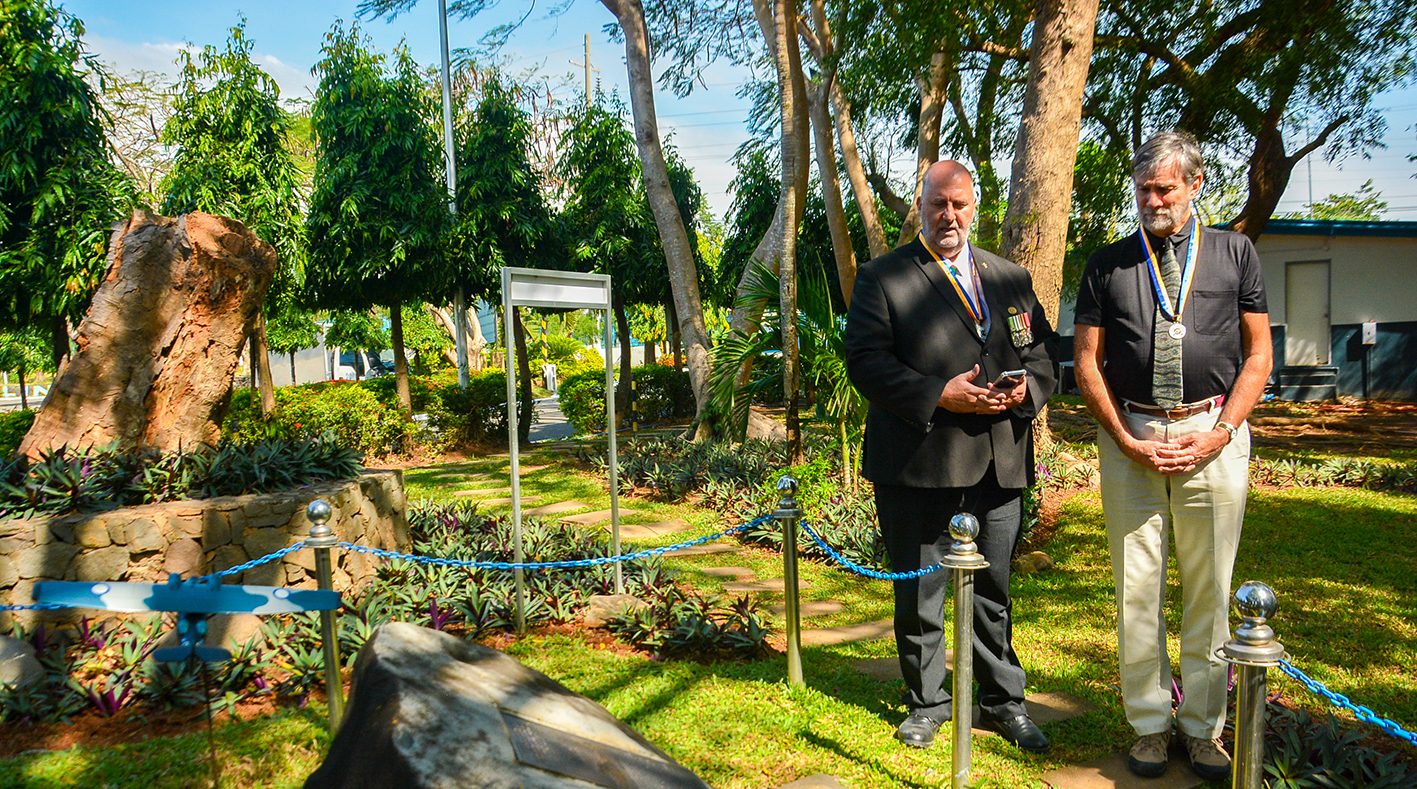
Corregidor
For Bob, the tour had actually started a few days earlier with a visit to Corregidor. Part of the rim of a volcano, one of 27 volcanic vents in a 320-kilometre-long chain sitting above the zone where the earth’s crust slides down under the coast of Luzon into the Manila Trench, it’s easy to see how the volcano’s last eruption hundreds of thousands of years ago may have led to the formation of the bay whose entrance it now guards.
Established by the Spanish as a signal station in the early 1800s, aggressive pirate raids led to fortifications being built on the island by the 1850s, followed by artillery batteries and electric searchlights which were in place by the time the American naval squadron stole into the Bay to annihilate the Spanish fleet at the start of the American – Spanish War in 1898. In American hands the construction of substantial fortifications commenced in 1904 with ‘a maze of defensive works’ including tunnels and artillery batteries making the island seemingly ‘impregnable against any probable naval attack’. By December 1941 however, with little attention paid to defence against air attack or funding for improvements during the 1920s and 1930s, the fortifications were becoming obsolete and, although there had been some improvements including a kilometre of ‘concrete-lined tunnel’, contracts for a modernisation program were still being negotiated.
Despite this, it was on Corregidor that MacArthur ensconced himself just over two weeks after the Japanese attack on Pearl Harbor and two days after the main Japanese invasion force landed in the Lingayen Gulf on 22 December 1941. And it was from Corregidor, just over two and a half months later during a lull in the fighting as the Japanese waited for reinforcements to finish their conquest of the US and Filipino forces trapped on Bataan and Corregidor, that MacArthur had himself evacuated to Australia where he was placed in charge of that nation’s defence.
Australians returned to Corregidor two months after the RAAF Catalinas mined the shipping channels running either side of it with the Australian cruiser HMAS Shropshire, supported by the destroyers HMA Ships Arunta and Warramunga and the requisitioned supply ship HMAS Yunnan, participating in the bombardment of the island as US paratroops recaptured it in February 1945. An Australian was also involved in the recapture two months later of El Fraile or Fort Drum, a reef lying between Corregidor and the southern shore of Manila Bay which had been turned into a fortress by constructing a concrete, battleship-shaped citadel with walls from eight to twelve metres thick and a roof almost seven metres thick. To assist in the attack, an Australian Army Bombardment Liaison Officer was detached to the USS Phoenix, a ship later sold to the Argentinians, renamed General Belgrano and sunk by a British submarine during the Falklands War.
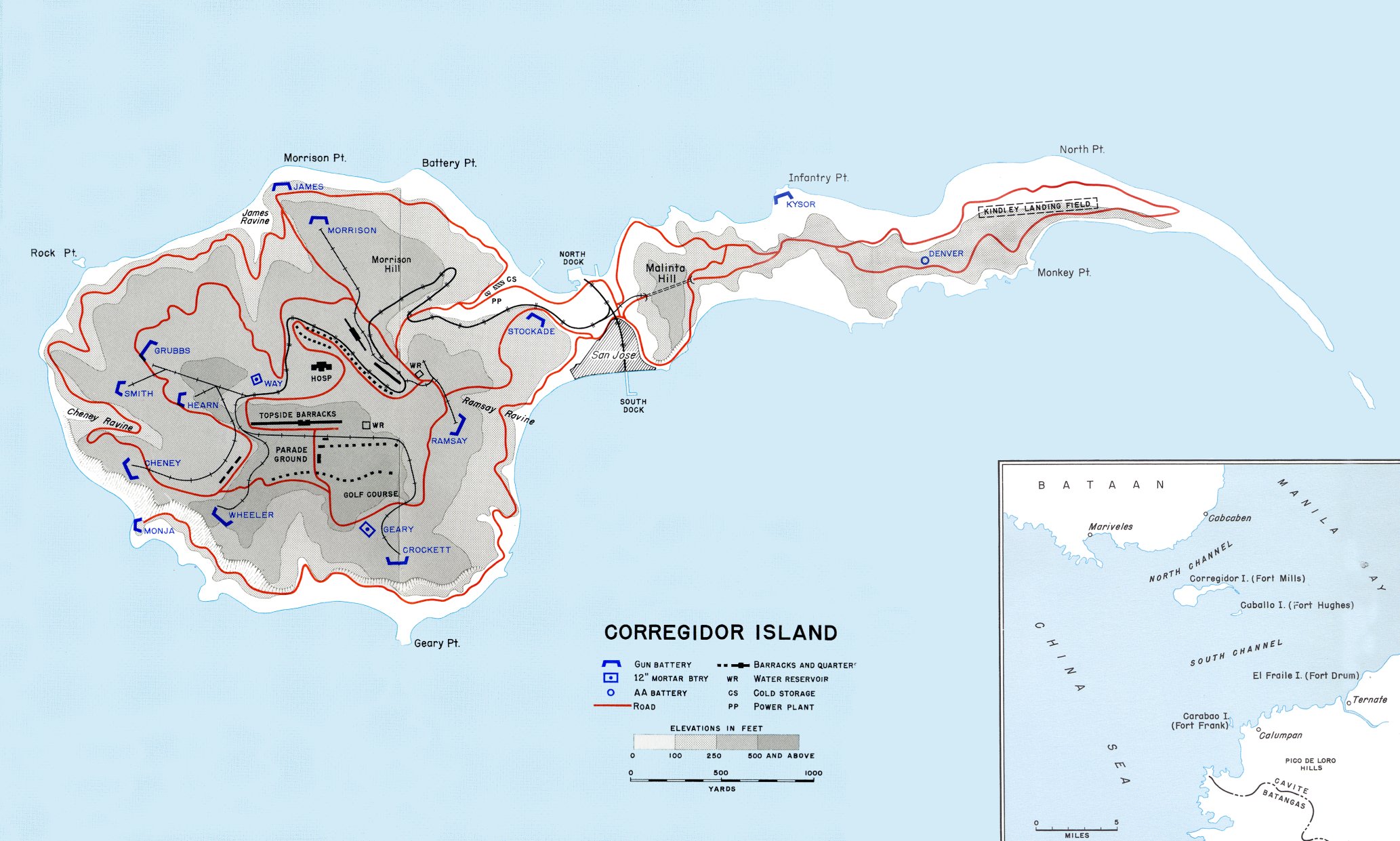
During his visit to Corregidor, Bob paid a visit to the Pacific War Memorial which was ‘erected to the Filipino and American fighting men who gave their lives to win the land, sea and air victories which restored freedom and peace to the Pacific Ocean Area’. In accordance with its Pacific Ocean Area focus, the only Australians recorded on the memorial as participants in the battles commemorated are the ‘Australian Coast Watcher Warning Units’, the majority of Australians having fought in the neighbouring South West Pacific Area or South East Asia Command.
Mount Samat
During our journey down the Bataan Peninsula to MAAP on the morning of the ceremony, we paid a short visit to Mount Samat on our way past. Mount Samat is a 460-metre-high parasitic cone on the lower slopes of the southernmost of the two massive dormant volcanoes that form the peninsula, the next two in the chain immediately to the north of Corregidor, and it dominates the low ground between them. As such, it had been vital ground in the second defensive line adopted by US and Filipino troops between Bagac and Orion as they withdrew down the peninsula towards Corregidor in January 1942. It was soon after this defensive line was established that there was a lull in the Japanese attacks while they waited for reinforcements and MacArthur was evacuated. The Japanese capture of Mount Samat shortly after they renewed their offensive a month later precipitated the fall of Bataan within four days, and Corregidor a month after that. Given its significance in the fall of the Philippines, a memorial complex was later established on the peak consisting of a large cross visible from some distance, a shrine and a museum. Surprisingly, the museum has on display two Australian SMLE .303 rifles which were reportedly used by Australians troops on Leyte.
Over two and a half years later, on the night of 14 December 1944, RAAF Catalinas crossed the Bataan Peninsula between the two volcanoes into Manila Bay tracking along where the defensive line had been, with one crew recording Mount Samat visible ‘slightly off our track to starboard’, before turning south along the coast of the bay to drop their mines in the shipping channels inside of Corregidor. Our journey from Mount Samat to MAAP for the ceremony had shadowed their flight path. On our departure from MAAP, we backtracked along the same road and continued further north, following the route of the Bataan Death March.
Bataan Death March, Capas National Shrine and Cabanatuan Prison Camp Memorial
With the fall of Bataan on 9 April 1942, up to 10,000 American and more than 60,000 Filipino soldiers became Japanese prisoners. Already starving and thirsty from MacArthur’s lack of logistical planning, and exhausted from holding out against the overwhelming Japanese forces for months the ‘battling bastards of Bataan’, as they had become known, were gradually collected into a column starting in Mariveles on the southern tip of the peninsula and force-marched north out of the way of the Japanese forces massing to attack the US headquarters on Corregidor. Deprived of food, water and medical treatment, and subjected to extreme physical violence, the prisoners were marched some 100 kilometres to San Fernando, where they were herded on to railway freight cars for the remainder of the journey to their new prison at the former Philippine army base at Fort O’Donnell. Approximately 600 Americans and an estimated 15,000 Filipinos died on what has become known as the ‘Bataan Death March’. We followed some 55 kilometres of the Death March route as we left the memorial at MAAP, with part of the route having been shadowed in reverse by the RAAF Catalinas as they followed the coast of Manila Bay south towards Corregidor. A marker every kilometre is a permanent record of the route.
The day before the ceremony we had already visited the Capas National Shrine, which is built on the site of the Camp O’Donnell prisoner of war camp where an additional estimated 21,000 Filipinos and 2,500 Americans died. The Shrine, located in an expansive park, consists of a 70 metre obelisk surrounded by gloss black marble memorial walls engraved with the names of Filipinos known to have died during the Death March or in the prison camp. To the side of the memorial, one of the original freight cars used in the Death March is exhibited as a reminder of the extreme suffering endured by the men. A small yard also contains memorials to all who suffered at Camp O’Donnell and includes a wall engraved with a list of the Americans who died there.
In June 1942, less than three months after arriving at Camp O’Donnell, the approximately 6,000 surviving American prisoners were transferred to another prison camp near Cabanatuan 50 kilometres to the east, where they were eventually joined by approximately 14,000 more American and Allied servicemen and civilians. I had visited the memorial established on the site of the camp on my way down to meet Bob, where the names of the almost 3,000 American servicemen who died there are inscribed on the wall standing behind the remains of the camp water tower.
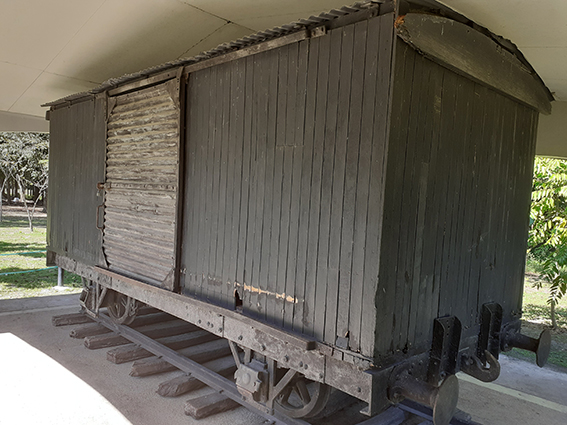
From Cabantuan, groups of prisoners were gradually dispersed to other camps and forced labour sites in the Philippines, Taiwan, China and Japan. After the Leyte landings in October 1944, however, the Japanese attempted to transport as many American prisoners out of the Philippines as possible. On 13 December, as the Allied landing force closed on Mindoro, all but about 500 of the remaining prisoners left in Cabantuan joined those from other prison camps on Pier Seven in Manila, where all 1,619 of them were crammed into the holds of the Japanese transport ship Oryoku Maru. The last ‘hell ship’ to transport prisoners out of Manila Bay, Oryoku Maru sailed out past Corregidor in the early hours of the following morning and was attacked soon after dawn by US Navy aircraft covering the approaching landing force, forcing the vessel to seek shelter in Subic Bay overnight, the very night the RAAF Catalinas mined Manila Bay.
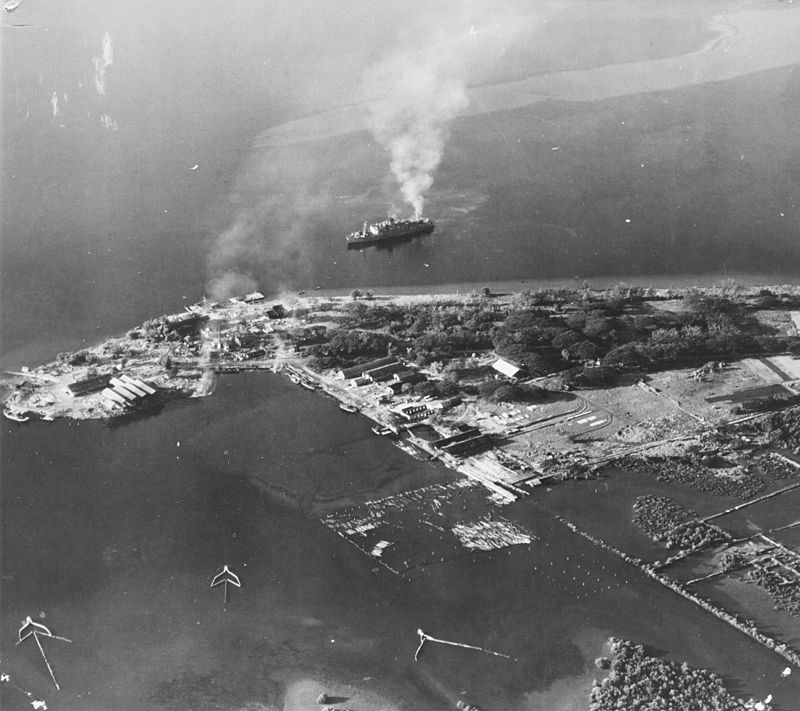
Subic Bay
At least one Catalina flew part way in over Subic Bay and a second actually flew out over it during the mission, unaware of the unimaginable horror transpiring below them. Weakened by years of suffering in prisoner of war camps and having been crammed in the ship’s holds for two days without sanitation, adequate ventilation and enough food and water, the American prisoners were dying in the worst ways possible. With dawn came the return of the US Navy aircraft, their attacks this time sinking the ship about 275 metres off shore from the naval base. More of the prisoners were shot by the Japanese as they tried to swim ashore. When the prisoners were mustered ashore, it was found that 286 had been lost since boarding two days earlier. The survivors were eventually loaded onto other vessels bound for Japan only to endure further tragedies, with only 450 of the original 1,619 prisoners surviving the journey. A memorial dedicated to the prisoners of war of all nations who suffered and died while being transported by their Japanese captors on hell ships has since been erected on the shore opposite where the Oryoku Maru still lies.
Returning to Subic where we were staying overnight after the ceremony at MAAP, we arrived back in time to also attend the American 75th anniversary ceremony held to remember the American prisoners killed on the Oryoku Maru. With a plaque on the memorial specifically dedicated to the 845 Australian prisoners of war and 208 mainly Australian civilians who died when the Montevideo Maru was sunk off Cape Bojeador in northern Luzon in 1942, we also remembered the suffering that they endured on that deadliest day of the Second World War. We also visited the local American Legion Post which still displays the Oryoku Maru’s forward 3-inch gun, converted into a memorial, in front of it.
The Australian forces have had a long relationship with Subic. On 29 January 1945, HMAS Warrego was among the first Allied ships into Subic Bay with the Minesweeping and Hydrographic Unit of the Mike VII landing force. The force was tasked with securing the San Marcelino airstrip near Clark, opening Subic Bay to Allied shipping, and trying to cut the Japanese off and stop them withdrawing into the Bataan Peninsula in a repeat of history. That relationship continues to this day, and looking out over the Hell Ships Memorial to the former US Naval Air Station Cubi Point, we also remembered the three men of the Australian Special Air Service Regiment who lost their lives when the US Air Force Hercules which had extracted them from there during a 1981 exercise crashed into the South China Sea shortly after takeoff in the largest loss of Australian SAS lives in a training accident outside of Australia. Two members of the New Zealand SAS, two members of the Philippine Navy special forces and sixteen US servicemen were also killed in the accident, which is remembered every year with a wreath dropping from a US Air Force aircraft over the crash site.
Bob and I parted ways in Subic, Bob needing to return to Manila for his flight out and I to attend the official opening of the new RSL Sub-branch rooms in Angeles City which have been named in honour of Keith Payne, VC AM, and which he also attended.
Clark and Manila Military Cemeteries
The RSL’s annual ANZAC Day and Long Tan Day ceremonies are held at the Clark Veterans Cemetery, which contains the remains of US servicemen and civilians who have died in the Philippines since at least the Philippine-American War of 1899-1902 right up until the present day. As such, we had also included it in our short tour itinerary. Once back in Manila, Bob also visited the Manila American Cemetery, the largest American war cemetery outside the US mainland containing 17,184 US war graves and the names of 36,286 servicemen missing or buried at sea. The only non-US, non-Second World War grave in the cemetery is that of a First World War British sailor who drowned in Manila Bay and was reinterred in the cemetery from another cemetery in 1973. He was originally buried near another First World War veteran, the Royal Australian Navy’s first Australian-born Fleet Commander and the only known Australian First World War veteran buried in the Philippines, Rear Admiral John Saumarez Dumaresq. The Admiral has since been reburied in an unmarked grave a few kilometres away. Despite only being buried in the Philippines due to passing away while transiting, it is probably a fitting burial ground for him given his role in the last major battleship gun battle prior to the Battle of Surigao Strait, the Battle of Jutland, and his vision for the future of naval aviation which unarguably played a major role in the liberation of that country.
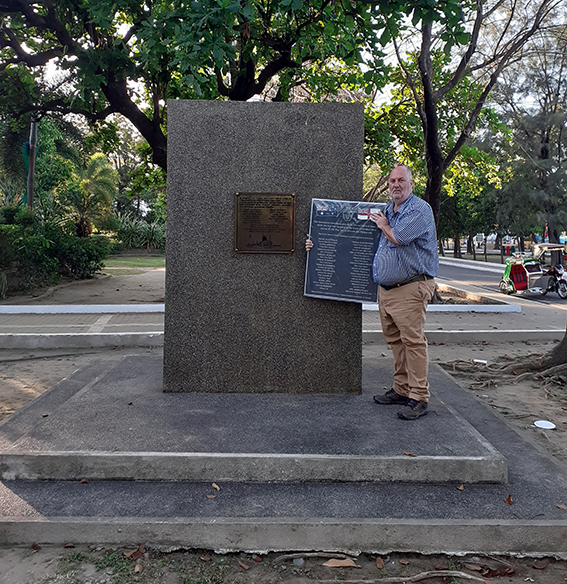
Lingayen
From Angeles City, I headed north to Lingayen, passing on the way the Centrale Azucera de Tarlac sugar mill in San Miguel where MacArthur’s primary signals intelligence unit, the RAAF’s 6 Wireless Unit staffed by air force intercept operators and Australian Army linguists and analysts, had established themselves after the Lingayen landings and from which they continued to operate until the end of the war. Surprisingly, the vast majority of trucks carting sugar cane to the mill are still former US Army 6×6 types.
With the assistance of our former RSL President James Curtis-Smith, I was in Lingayen to hand over a replacement plaque from the Naval Commemoration Committee of Victoria for installation prior to unveiling during the 75th anniversary of the Lingayen landings on 9 January. However, I can’t visit Lingayen without thinking about the two other Australian military history connections to the town.
On a clear day, Cabalitan Bay is clearly visible from the beach. From that bay, many young Australian airmen set out in the ageing and ubiquitous Catalinas on the northernmost missions of the RAAF in the war against Japan, mining the coasts of China and Taiwan and stemming the flow of resources back to Japan until their role could be taken over by the new US B‑29 Superfortresses. And it was from that bay that Catalina A24-203 took off on its fatal mission into the Taiwan Strait in March 1945, nine Australian sons never returning home.
As a former tank soldier, the M-24 Chaffee tanks on display near the RAN plaque remind me of the first time Australians and Filipinos fought shoulder to shoulder following the Lingayen landings. The Filipinos only ever used the tanks in Korea and, in a desperate attempt to break through to the encircled Glosters on the Imjin River, the Filipino M-24s joined a column of British Centurions, including a troop under the command of the first Australian to take that doyenne of the battlefield into action. The effort was to no avail, but the courage displayed by all involved was remarkable. And on that note…. Baker, out.




